FIVE TO SEVEN YEARS
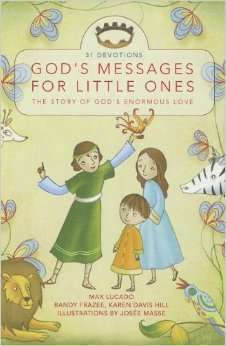 Lucado, Max, Randy Frazee, and Karen Davis Hill. Illustrated by Josee Masse. God’s messages for little ones: the story of God’s enormous love. Grand Rapids, MI: Zonderkidz, 2012.
Lucado, Max, Randy Frazee, and Karen Davis Hill. Illustrated by Josee Masse. God’s messages for little ones: the story of God’s enormous love. Grand Rapids, MI: Zonderkidz, 2012.
Well-known pastor and author Max Lucado leads a qualified team to present this devotional for children. With 31 devotions, the book can be consumed in a month with reading one a day. Parents can read it to their children but most six and seven year olds should have little trouble reading it on their own. Each devotional comes with an illustration of a Bible story and three textual components. The first component is a brief paraphrase of a scripture verse with a reference to the Bible story. The second component is a short three-line poem that summarizes some practical theological points from the story. The third component is a section called “God says to me.” This final part is a blessing/prayer/promise over the child spoken from the perspective of God towards the reader (http://www.familychristian.com/gods-messages-for-little-ones-31-devotions.html).
 Lloyd-Jones, Sally and Jago. Thoughts to make your heart sing. Grand Rapids, MI: Zonderkidz, 2014.
Lloyd-Jones, Sally and Jago. Thoughts to make your heart sing. Grand Rapids, MI: Zonderkidz, 2014.
From the author and illustrator of The Jesus Storybook Bible comes a book of 101 devotions with Scripture references that can be used by children and adults (http://www.zondervan.com/thoughts-to-make-your-heart-sing-deluxe-edition).
Wilhelm, Hans. Waldo, tell me about God. Norwalk, CT: C.R. Gibson Company, no date.
This short book is about a conversation between a boy and his talking dog named Waldo. The book begins with Waldo mentioning the handiwork of God and then the boy saying, “Who is God?” What follows is a series of answers from Waldo about the character and nature of God. The illustrations are appealing and the theology is Biblically sound. The main thrust of the story is about God’s enduring and ever-present love. A PDF version of the book is available online here: (http://www.childrensbooksforever.com/Childrenpics/WALDO%20TELL%20ME%20ABOUT%20GOD.pdf).
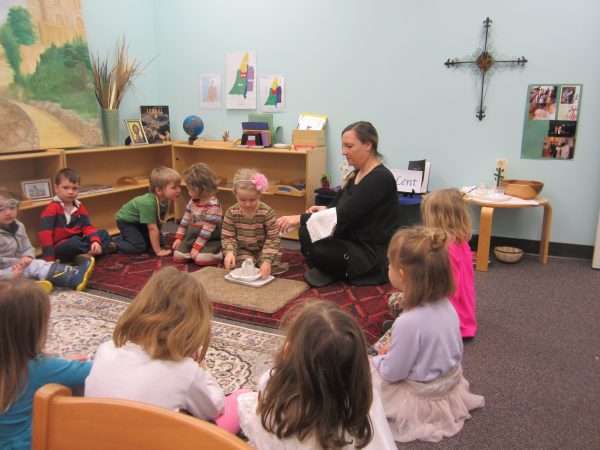 Catechesis of the Good Shepherd.
Catechesis of the Good Shepherd.
This is an excellent program developed originally by Sofia Cavalletti and Gianna Gobbi with influence from Maria Montessori. It essentially takes the Montessori method of teaching children and transfers it to religious education. The “atrium” is the setting, which is kind of “halfway house” between the classroom and the sanctuary. Children both learn and worship in a way that is attentive both to God’s spirit as well as the needs, interests, and learning styles of the children. Lessons allow children to explore the stories of the Bible and the traditions of the church through interactive group experiences facilitated by a teacher (http://www.cgsusa.org/).
Berenstain, Jan and Mike. The Berenstain Bears: Show God’s Love. Grand Rapids, MI: Zonderkidz. 2010.
This single volume is a compilation of five Berenstain Bears stories. Each story teaches a Biblical concept. For example, the first of the five stories, Love Thy Neighbors, is a modern re-telling of The Good Samaritan story set in bear country. In this story, the bear family is surrounded by many neighbors in their town, most of whom appear to be all-around good people. Then there are the Bogg brothers. They live in a run-down shack, drive a beat-up car, raise dirty pigs, and spit in people’s properties when they drive by. But then the bear family’s car runs down on the way to the town festival. Both the mayor and the wealthy squire (who appear to be good people) whisk by the bear family on the road. Then come the Bogg brothers, who end up helping the bear family on their way and covering the costs for their car to get fixed at Uncle Zeke’s rusty repair shop. Each story opens with the corresponding Scripture reference so parents can discuss the Biblical basis for each story with their children (http://www.amazon.com/Berenstain-Bears-Show-Living-Lights/dp/0310720109).
Berryman, Jerome. The complete guide to Godly play. Vols 1-8. Denver, CO: Living the Good News/Morehouse Education Resources, 2002-2012.
Similar to the Catechesis of the Good Shepherd mentioned above, Godly Play is a model/method of helping children experience God and the stories of God in a Montessori-like setting. Berryman has developed a series of lessons using simple wooden figures and other tactile materials that allow children to interact with and explore the stories of the Bible. The overall mood is reverent and reflective as the teacher leads the children in an attitude of wonder towards the stories of God. Below are some online links that explain more and show examples of Godly Play in action:
- The main website – http://www.godlyplayfoundation.org/
- A good summary of Godly Play – http://www.buildfaith.org/2013/07/01/godly-play-for-all-ages-all-abilities/
- Godly Play in Germany – https://www.youtube.com/watch?time_continue=360&v=py6vzIs_NcM
- My personal reflections on Godly Play from my blog – http://jessejoyner.com/godlyplay-a-model-for-ministry-with-children/
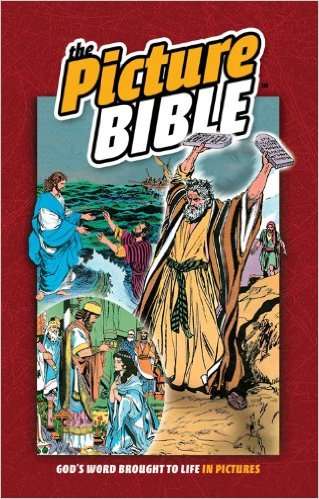 Hoth, Iva. The Picture Bible. Andre Le Blanc illustrator. Colorado Springs: David C. Cook. 1998.
Hoth, Iva. The Picture Bible. Andre Le Blanc illustrator. Colorado Springs: David C. Cook. 1998.
This is a comic-book styled Bible. The stories are illustrated with bubble texts coming from the mouths of the characters. With over two hundred stories from the Bible along with maps and “Did You Know?” excerpts, this book helps children (especially those familiar with comic book literature) engage with the stories of the Bible.
Vischer, Phil. Buck Denver asks…What’s in the Bible? Church edition. Jellyfish Labs, 2014.
This is a 52-week curriculum for use in children’s ministry settings. Phil Vischer, the creator of Veggie Tales, has headed up this project that teaches kids deep spiritual truths through puppetry, songs, and storytelling. I personally like the emphasis on Biblical theology taught by Vischer. The Veggie Tales franchise was very successful, but it seemed a little shallow on Biblical “meat” (which may have been the intent in order to reach a wider audience). This curriculum is unashamedly Bible-focused and Vischer speaks directly to the audience through the camera in a pastoral teaching role. Here is the link to the curriculum resource: (http://whatsinthebible.com/). I also wrote my own blog post reviewing it: (http://jessejoyner.com/whats-bible-curriculum-review/).
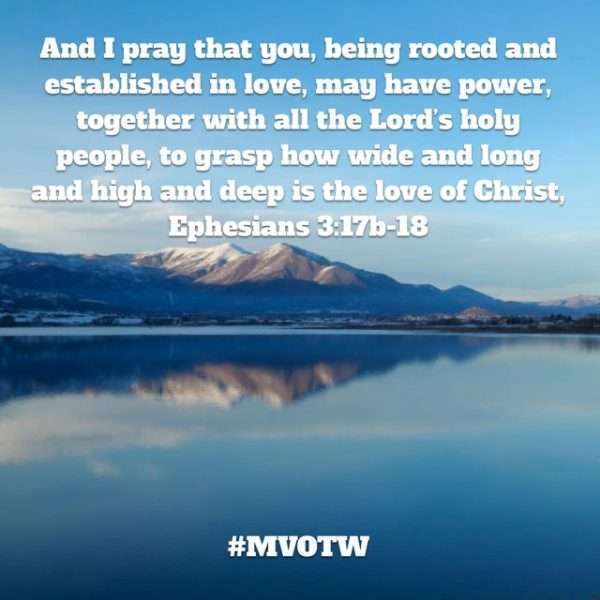 Memory Verse of the Week.
Memory Verse of the Week.
MVOTW – This acronym stands for “Memory Verse of the Week.” I speak at summer camps every year and several years ago I gave the memory verse of the week at one of the camps this nickname and the kids loved saying it (pronounced “muh-vah-twah”). We also added a dramatic motion to go with it (slowly raising one’s arms above the head to form the letter “M” over the head while emphatically saying “MVOTW!”). The boys then do a muscle-man pose while the girls jump like cheerleaders and kick one leg back. I, of course, give them the option to do either motion at the end so as not to reinforce any potentially negative gender stereotypes (such as ‘girls can’t be strong’ or ‘boys can’t be cheerleaders’). But nobody has ever had a problem with it because it is all done in jest. The MVOTW consists of the memory verse itself put to motions (some sign language mixed with made-up silly motions) and then the dramatic MVOTW pose at the end. For several years now, the MVOTW has been a huge hit with kids, especially preteens. My own five-year old daughter found this method to be helpful in memorizing Scripture. Here is a YouTube video of eight hundred kids and leaders reciting 1 John 4:4 using the MVOTW model: (https://www.youtube.com/watch?v=-PIV-v86qe0).
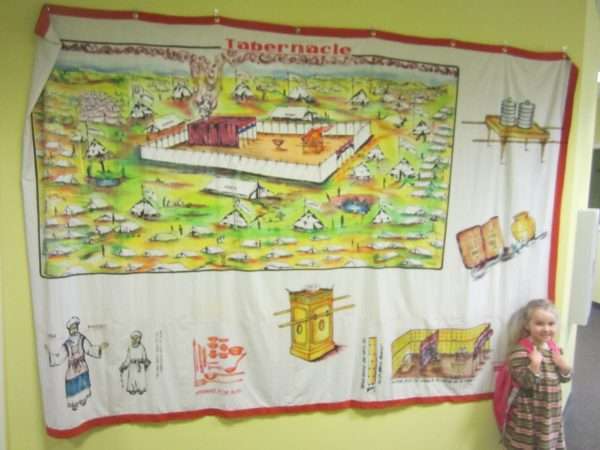 Tabernacle Diagram Canvas – Alpha Artistic Evangelism.
Tabernacle Diagram Canvas – Alpha Artistic Evangelism.
This unique wall canvas at my daughter’s Christian Montessori school depicts the Israelite Tabernacle when they were wandering through the desert between Egypt and the Promised Land. It shows the tent city, the tabernacle, and close-ups of the Ark of the Covenant and what it all may have looked like during this period before the construction of the permanent temple in Jerusalem. It’s large size allows teachers and parents to show children a visual of the worship practices of God’s people in the Old Testament. I cannot find a solid reference for the work, so let it be an inspiration to create large images as aids for children to better understand the cultural and historical settings of the Bible. Below is a picture with a child to give proportion:
Family Fun Puzzle: Hosanna in the Highest! Grand Rapids, MI: Zondervan, 1998.
This 100-piece jigsaw puzzle depicts Jesus riding into Jerusalem on a donkey at what is called his “triumphal entry.” This is a great family activity for Palm Sunday weekend. The parents and children can assemble the puzzle as they talk about the meaning of Palm Sunday and how Jesus is the humble King who has come to save.
*This list comes directly from a paper I wrote for a class at Trinity Evangelical Divinity School in Deerfield, IL in March 2016. The class was ES 7524 (Education and Ministry Experiences for Children) taught by Dr. Magdalene Larson.



